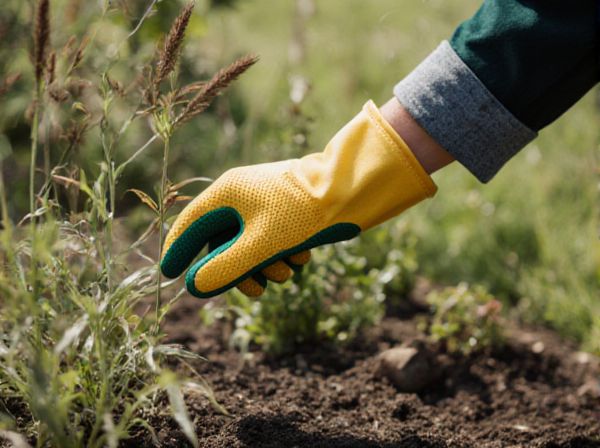
Dry Garden vs Bog Garden Illustration
A dry garden thrives on drought-tolerant plants and gravelly, well-drained soil, creating a low-maintenance landscape ideal for hot, arid climates. In contrast, a bog garden requires consistently moist, acidic soil and supports water-loving plants such as carnivorous species and moisture-dependent shrubs. Choosing between a dry garden and a bog garden depends on your local climate, soil conditions, and the water availability to sustain the desired ecosystem.
Table of Comparison
| Feature | Dry Garden | Bog Garden |
|---|---|---|
| Soil Type | Sandy, well-drained soil | Moist, acidic, water-retentive soil |
| Water Requirement | Low, drought-tolerant plants | High, consistently wet conditions |
| Plant Types | Succulents, cacti, lavender, ornamental grasses | Carnivorous plants, irises, ferns, marsh marigold |
| Maintenance | Low to moderate; occasional watering | Moderate; constant monitoring of water levels |
| Ideal Climate | Arid, Mediterranean, temperate climates | Temperate, wetland, and coastal climates |
| Landscape Purpose | Water conservation, xeriscaping | Wetland habitat creation, water filtration |
Introduction to Dry Gardens and Bog Gardens
Dry gardens feature drought-tolerant plants thriving in well-drained, arid soils, emphasizing minimal water usage and sustainable landscaping. Bog gardens replicate wetland conditions with consistently moist, acidic soils, supporting moisture-loving plants like carnivorous species and sedges. Both garden types enhance biodiversity by catering to specialized plant communities adapted to contrasting moisture environments.
Key Differences Between Dry and Bog Gardens
Dry gardens feature drought-resistant plants and well-drained soil, ideal for arid climates and low water usage, while bog gardens require consistently moist or waterlogged soil, supporting moisture-loving plants like carnivorous species and marsh marigolds. Soil composition and water management are critical, with dry gardens using sandy or gravelly substrates to prevent water retention, contrasting with the peat-rich, nutrient-dense soils in bog gardens. Plant selection in dry gardens emphasizes succulents, cacti, and ornamental grasses, whereas bog gardens thrive with sedges, rushes, and moisture-dependent wildflowers.
Ideal Plants for Dry Gardens
Ideal plants for dry gardens include drought-tolerant species such as lavender, sedum, and ornamental grasses like blue fescue, which thrive in well-drained, low-moisture soils. Succulents like hens and chicks, as well as native Mediterranean herbs such as rosemary and thyme, also flourish in arid conditions typical of dry gardens. These plants require minimal watering and are resilient against heat, making them perfect for sustainable dry garden landscapes.
Best Plants for Bog Gardens
Bog gardens thrive with moisture-loving plants such as skunk cabbage, marsh marigold, and cardinal flower, which adapt well to consistently wet soil conditions. These plants support biodiversity by attracting pollinators and amphibians, enhancing the ecological balance of the garden. Unlike dry gardens, bog gardens require plant species that can tolerate or flourish in saturated, acidic environments.
Soil and Drainage Considerations
Dry gardens require well-drained, sandy or gravelly soil to prevent waterlogging and support drought-tolerant plants. Bog gardens thrive in consistently moist, organic-rich, acidic soil that retains water and mimics natural wetland conditions. Proper soil and drainage management ensure optimal plant health and garden sustainability in these contrasting landscape styles.
Climate Suitability for Each Garden Type
Dry gardens thrive in arid and semi-arid climates where drought-tolerant plants such as succulents and cacti can conserve water efficiently. Bog gardens require consistently moist or waterlogged soil conditions, typically found in cooler, wetter climates with high humidity and frequent rainfall. Selecting the appropriate garden type based on climate suitability ensures plant health, reduces irrigation needs, and enhances ecosystem balance.
Watering and Maintenance Requirements
Dry gardens require minimal watering, relying primarily on drought-tolerant plants that thrive in well-drained soil, making maintenance relatively low. Bog gardens demand consistently moist or waterlogged soil, necessitating frequent watering and regular monitoring to maintain appropriate humidity levels. Maintenance in bog gardens also involves managing water quality and preventing stagnation, resulting in higher upkeep compared to dry garden environments.
Design Tips for Dry Gardens
Dry gardens require selecting drought-tolerant plants such as succulents, lavender, and ornamental grasses to maintain visual interest with minimal water. Incorporate gravel, sand, or decomposed granite for efficient drainage and to reduce soil moisture retention. Strategic placement of rocks and mulches not only conserves moisture but also adds texture and structure, enhancing the natural aesthetic of the dry garden design.
Creative Ideas for Bog Garden Layouts
Bog garden layouts thrive with creative incorporation of water-loving plants like carnivorous species, irises, and ferns amidst natural stone and shallow pools to simulate wetland environments. Utilizing layered plantings and varied textures emphasizes the lush, damp habitat, while integrating natural water features and bog soil enhances moisture retention and biodiversity. Innovative design elements such as wooden boardwalks or rustic bridges provide both aesthetic appeal and accessibility, creating immersive, tranquil spaces distinct from the drier, minimalist structure of dry gardens.
Choosing the Right Garden Type for Your Landscape
Selecting the right garden type depends on soil moisture and plant preferences; dry gardens thrive in well-drained, arid conditions with drought-tolerant plants like succulents and ornamental grasses, while bog gardens require consistently wet, acidic soil supporting moisture-loving species such as carnivorous plants and moisture-tolerant ferns. Understanding your site's drainage, sunlight, and water availability is crucial for establishing either garden type successfully. Both garden styles enhance landscape diversity by providing specialized habitats that support distinct plant communities with minimal maintenance.
Dry Garden vs Bog Garden Infographic

 gardendif.com
gardendif.com